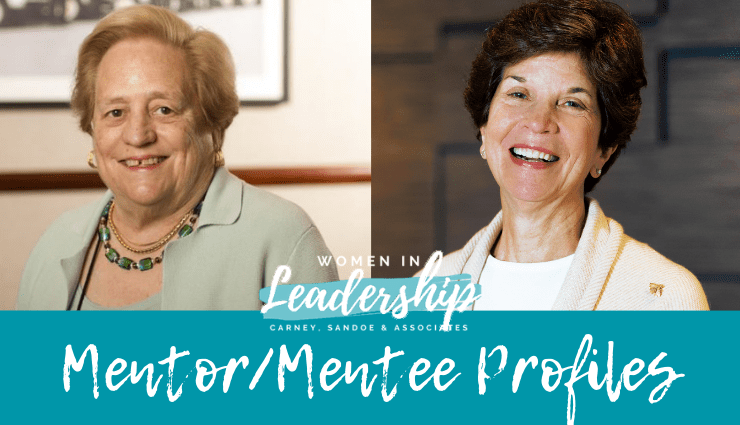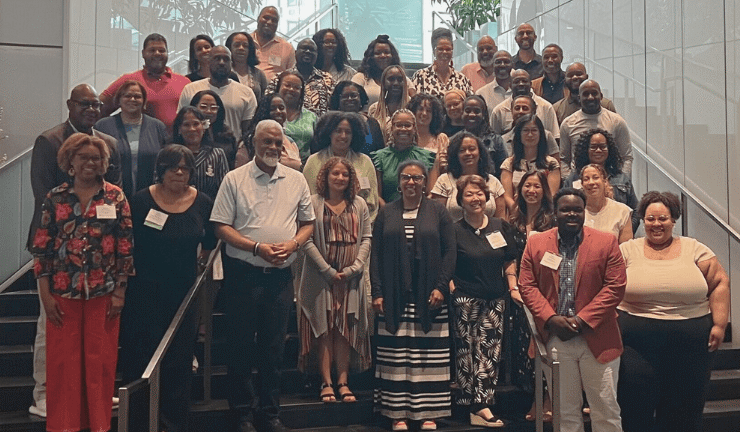Mentor/Mentee Profile: Cultivating the Next Generation

This spring, CS&A is shining a spotlight on women in leadership. This piece is one of a series of stories about female leaders in independent schools, the importance of mentorship, and their professional journeys. Find the full series here.
CS&A is proud to have hosted the third-annual Women’s Institute on June 14 in Boston, an event designed to support women and their allies in the education community. Our Placement and Search Groups are dedicated to increasing the number of women in leadership roles as part of our commitment to diversity, equity, and inclusion.
Coming out of college in late 1960s with a degree in history, Ann Teaff had it in her mind that she wanted to work in the U.S. Foreign Service. Teaching was not on her short list of possible professions because she felt it was the too-obvious choice for women of that era.
But after not getting into the Foreign Service (she couldn’t type fast enough), she accepted a temporary teaching position in a Catholic school where she discovered something important: she enjoyed teaching. A lot. Making a conscious commitment to education, Ann entered a graduate program in education at Vanderbilt University.
What has kept her going in the field of education all these years — what has motivated her time and again, she says — has been the chance not only to serve children but also to grow professionally and play a central role in improving schools, especially the education of girls.
What has also helped was having fabulous mentors along the way.
Following her graduate work, Ann began teaching at University School of Nashville, first as a middle school English and history teacher and then in the Upper School as a teacher of history, economics, and political science. When a history department chair position opened up at Garrison Forest School in Baltimore, Ann applied and was hired. She saw this as an opportunity to teach girls and develop her professional skills. It also helped that Aggie Underwood was the head of Garrison Forest at the time. Ann sensed right away that Aggie would be a good person to work with. Aggie exudes a kind of confidence, enthusiasm, and energy that Ann both admires and finds instructive.
As it turns out, Aggie would end up serving as an important mentor in Ann’s life and career, one that would span decades and help Ann move from teacher to department chair to upper school head to assistant head — and finally to head of school.
At Garrison Forest School, Ann started as the chair of the history department and a full-time teacher while also working as the faculty director of the school’s community service program and as an admissions facilitator. With Aggie’s encouragement, she would eventually advance to the head of the Upper School and then assistant head, a position she held for 10 years.
Eventually, Ann would leave Garrison Forest to take her first and only headship position at Harpeth Hall School in Tennessee, where in 16 years she led the school through two successful capital campaigns, collaborated with other school heads in establishing the remarkably successful Online School for Girls, formed the innovative Center for STEM Education for Girls, increased enrollment by more than 25%, and instituted student international exchanges. The two capital campaigns led to a new Library building, the complete renovation of the Upper School, a new Middle School building, a Visual Arts Center and a state-of-the-art Athletic and Wellness Center.
Much of this work, Ann says, was made possible because of the foundational work she did at Garrison Forest and through the support and feedback of a mentor who made sure Ann had the opportunity to develop her leadership abilities.
“Aggie is such an icon in the independent school world,” Ann notes. “But when I first started at Garrison Forest, she was a young head still finding her own way. What stood out about Aggie even back then was that she took an interest in people — and in me in particular. I always tell people that she saw more potential in me that I saw in myself. In all honesty, at that point, I wasn’t thinking beyond being a history department chair. But Aggie helped me build my self-confidence and my leadership skills.”
Their relationship wasn’t a formal mentor-mentee relationship. Ann says that Aggie just gave her opportunities to lead in the school community and offered honest, valuable feedback along the way. Ann would serve on a number of committees while working as the department chair. When the position of upper school head opened, Aggie encouraged Ann to apply and supported her in the work. This was the start of Ann’s transition to a lead administrator. She never looked back. Given her respect and trust for her boss, she opened herself up to being mentored, would ask for help and advice, and listen carefully — and grow in both skills and confidence.
“What was so helpful to me was Aggie’s positive spirit,” Ann says. “For her, anything was possible. Challenges were opportunities. When I said I wanted to take a year off to attend the Klingenstein program in New York, for instance, she didn’t think about the annoying prospect of replacing me for a year. Instead, she immediately saw this as an opportunity for me to advance my leadership skills. She even loaned me her station wagon to help me move to New York. Aggie was so attentive to the little things.”
When Ann decided to apply for the headship position of Harpeth Hall, she says Aggie was also supportive and offered excellent advice that made the transition year easier than it otherwise might have been. She also served as a sounding board for Ann over the years when they were both heading schools.
Aggie and Ann were among those independent school leaders of the 1990s involved with all-girls schools who have helped lead the remarkable revolution in girls’ education — which in turn has sparked changes in schools everywhere. Almost overnight, girls schools morphed from buttoned-down institutions to leading-edge schools, offering students greater agency in their learning, instituting global and cutting-edge curricula, and offering girls myriad opportunities to learn and grow in confidence. These schools piloted STEM and internship programs that are now widely embraced. They created programs with built-in opportunities for student collaboration, critical thinking, and creativity. Ann will be the first to say that these were exciting times to be involved in education — and they offered her the sort of professional challenge and fulfillment that she had been looking for back in college.
Aggie Underwood has her own backstory, of course. After earning a B.A. in economics from Connecticut College, she began her long and stellar career in education at Shady Hill School (Massachusetts). Here, she cut her teeth in the school’s long-running graduate-level, teacher-training program, a highly respected program based on the apprenticeship model that has launched hundreds of teaching careers.
Aggie moved from Shady Hill School to The Spence School, an all-girls school in New York, where she taught fifth grade and later chaired the social studies department, teaching history and economics in the middle and upper schools and heading the upper school. She would eventually take time away from teaching to earn her MBA at Columbia University, then returned to education as head of Garrison Forest School where in her 11-year tenure she transformed the school in ways that put it on the national map. Under Aggie’s leadership, the academic program became both more rigorous and cutting-edge and was led by a highly talented faculty, many with advanced degrees. The school improved it arts programming, and through marketing and outreach, increased student diversity. Enrollment and reputation grew significantly.
After Garrison Forest, Aggie became the head at National Cathedral School in Washington, D.C., where for 14 years she led this high-profile girls school through its own transitions to a thriving, cutting-edge school.
Aggie is now vice president and a managing associate at Carney, Sandoe & Associates. Looking back now, she can’t recall the exact number of educators — men and women — she has mentored over the years. But she knows that at least a dozen of her mentees went on to headships — split about 60% women, 40% men. Many are still in schools. Some are retired now or, like Ann Teaff, doing school consulting work.
Running a school isn’t easy work, so one might wonder why a head of school would add to the challenge by serving as a mentor. For Aggie, it’s hardly a question. You do it for the school, for the students, and for the talented individual educators who deserve the opportunity, she says. You do it for the collective independent school community. You do it for a world that desperately needs schools to function at their highest level. And you do it for yourself.
“There’s so much joy and satisfaction is seeing young, talented educators grow and develop over the years — and then step into positions of leadership,” Aggie says. “It’s one of my favorite aspects of being a school leader.”
For most educators, working in schools is more of a calling than a job. So if the goal is to help students thrive — it only makes sense, Aggie says, to help talented educators rise to positions of authority in which they can help improve schools.
Ann Teaff is a case in point.
When serving as head at Garrison Forest School, Aggie was looking for a talented history teacher to run the history department. “We had a good department,” she says, “But I knew it could be a great department. We just needed to find the right person to guide it to the next level.” Through a friend in another school, Aggie learned about Ann Teaff, a talented history teacher who would be perfect for the Garrison Forest position.
As Aggie expected, Ann did a fabulous job taking the history department to the next level — and would go on to serve the school exceptionally well as the upper school head, then assistant head of school.
Aggie says she didn’t make a conscious choice to mentor Ann. But she could see qualities in Ann that made it clear she had the potential to lead a school. “Ann has a passion for education in general, but particularly for girls’ education. She always went the extra mile at Garrison Forest and demonstrated a commitment to both the school and to her professional growth. She is the kind of educator who you know will improve the school in important ways — so you want to support her in every way possible.”
When the National Association of Principals of Schools for Girls (now The Heads Network) was holding its first Women’s Leadership Seminar at Garrison Forest, Aggie made sure that Ann attended. Over the years, she assigned Ann to various committees, including working with the board. “The goal,” Aggie says, “is to create an environment in which aspiring leaders are willing to take risks, test themselves — then offer them honest feedback.”
The independent school community,” she adds, “is only as good as its next leaders. So it’s imperative that those of us who serve as heads of school think about who will follow us. It’s particularly important that we identify and support women and people of color who can lead our schools in the years to come. As we all know, the percentage of women and people of color in headship positions is too low. Those of us who can help correct this statistic and move the community forward have an obligation to do so.”








